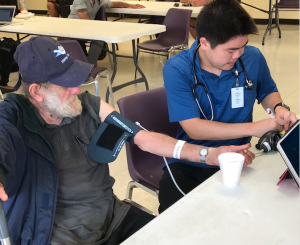
Medical student at First UMC in Honolulu checks the blood pressure of a Pancakes & Praise guest after worship.
The mandate given by Jesus to his followers was to take his authority to proclaim the counterculture Kingdom of God, to teach and demonstrate Spirit-empowered living, and to heal the sick and oppressed. As I have traveled the past 14 months consulting with churches throughout Europe and the U.S., I am witnessing some fresh alternatives to the traditional approach of getting people into our weekend worship events. Here are three among many that are faithfully breaking out of the box and accomplishing Jesus’ mandate:
Recovery Communities
Within months of becoming pastor of Ginghamsburg in 1979, I asked our board to approve using our sanctuary to host a local AA meeting. This seemed like a big ask for our small, rural church back in the day. I would smile though when I preached on Sunday mornings and spotted from the pulpit new cigarette burns in the carpet. Ginghamsburg went on to launch a Christian recovery support group and host other recovery groups before launching Next Step Recovery Worship on Saturday nights, thirteen years ago. In 2008, Ginghamsburg member Ron Will launched Joshua Recovery Ministries, which now runs six recovery homes for men across two counties. (For more on Joshua Recovery, view this video.) Ginghamsburg’s early involvement in recovery ministry was prescient in light of today’s opioid crisis. Dayton, Ohio, minutes south of Ginghamsburg, has been named as its epicenter.
Recovery ministry is something any church, no matter its size, can initiate for moving outside its walls and addressing a tremendous felt need in its surrounding community. The addiction crisis is no respecter of persons, race, neighborhood or socioeconomic status.
“Church” for the Homeless
This past March I was in Honolulu, Hawaii to consult with First United Methodist Church, Hawaii’s original Methodist Church established in 1855. My favorite ministry that I experienced at First UMC was Pancakes & Praise, a hot breakfast and worship service for Honolulu’s large homeless population. (The morning I worshiped with them, the actual menu was tuna and rice, eagerly consumed by possibly 100 guests that Sunday.) Pancakes & Praise is reminiscent of Ginghamsburg’s own Soul Food Café at our Fort McKinley Campus, where the hurting and underserved are also welcomed for breakfast and worship. Three Sundays of the month, medical students from the University of Hawaii show up to take care of guests after breakfast. They take blood pressure readings, treat minor wounds or medical conditions, and give health advice, among other services.
Serving with the poor in and among us creates some of the most powerful worship I have ever experienced. As Jesus noted, the poor we will always have with us. More than 2000 scriptures make plain God’s special concern for the poor. Clearly if the gospel isn’t good news for the poor, then it isn’t the gospel.
Neighborhood Communities
What I’m discovering as I visit and work with churches is that people may leave their “local church” for various reasons, but they don’t leave relationships. A church I consult with in Cincinnati has lost some of its key givers over the past year, and yet those formerly active members have not abandoned their church life group. I also believe that life groups alone, although essential, are not always enough. We need to think beyond traditional life groups toward launching healthy house churches. Simple organisms multiply faster than complex ones, and the house church can be a friendlier model to unchurched people who may not be attracted to a “big box store” church model. Watch this video to grasp the vibrancy of what can be accomplished through the relationships built in small group communities.
Your church size and context are not barriers to mission and ministry. Passion, a little out-of-the-box creativity, and a hunger to reach the least and the lost are the true essentials for Kingdom growth.
 Mike Slaughter
Mike Slaughter